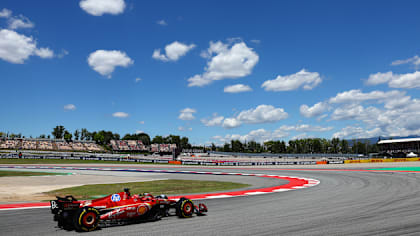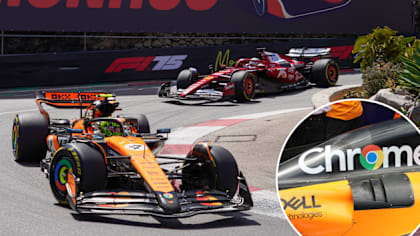Austin’s Turn 1 is one of the most visually iconic corners on the calendar, with the drivers climbing more than 30 metres in altitude in just a few hundred metres of asphalt. But which track on the calendar provides the drivers with the most ups and downs, and which has the biggest swing between its highest and lowest points? We provide the answers…
Major ups and downs
Spa-Francorchamps, Belgium

Elevation change (between highest point and lowest point): 102.2m
F1’s classic rollercoaster venue, Spa features both steep declines and sharp inclines, often in quick succession as at the famous Eau Rouge/Radillon section. The highest point of the circuit is the right hander at Turn 7 (Malmedy) and from there the drivers go downhill all the way to Turn 15 (Curve Paul Frere). The elevation change of 102.2m is more than the height of London’s Elizabeth Tower, better known as Big Ben.
Spielberg, Austria

Elevation change: 63.5m
Situated in the Austrian Alps, it’s perhaps unsurprising that Spielberg should feature significant elevation changes. The lowest point on the entire circuit comes on the start finish straight, yet by the time the drivers reach Turn 2 they have already climbed 63.3m - the same height as the Leaning Tower of Pisa.
Autodromo Jose Carlos Pace, Brazil

Elevation change: 43m
Interlagos is F1’s second highest track in terms of altitude, and it’s also one of its most topographically interesting. The highest point of the track is on the rise between the start-finish line and Turn 1, but from there the drivers plunge downhill all the way to Turn 5 – the lowest point on the circuit. All in all, the elevation difference between the highest and lowest points on this fabulously undulating circuit is 43m - practically the same height of Paris’ famous Arc de Triomphe.
Monaco

Elevation change: 42m
It may be short, but Monaco squeezes a lot of elevation changes into its 3.3km – not least at the start of the lap where the drivers climb what must feel like the side of a mountain from Ste Devote (Turn 1) all the way to the high point of Casino Square (Turn 4). If they could see over the barriers on their way up, they’d be able to spot the low point, which comes just before La Rascasse (Turn 17). Bizarrely, despite being on the harbour side, the lowest point is still technically 47.5m above sea level because in this instance ‘sea level’ refers to the average height of the earth’s oceans.
Suzuka International Racing Course, Japan

Elevation change: 40.4m
Elevation changes play a big part in making Suzuka a drivers’ favourite, and a quick look at the elevation trace above shows that it has considerably more ups and downs than most circuits. As you can see, the drivers are dropping downhill all the way from the final corners to the circuit’s low point between Turns 1 and 2, making braking particularly tricky. The high point is just out of the challenging Spoon bend (Turn13/14) – a corner that requires a good exit so as not to lose time on the undulating drag to 130R (Turn 15).
Hungaroring, Hungary

Elevation change: 34.7m
The Hungaroring was built within a valley, which not only provides spectators with excellent vantage points over much of the circuit, but also provides natural undulation. However, as the elevation trace shows, this circuit is more about a gentle rise and fall than several peaks and troughs, with the drivers dropping downhill until Turn 3 before a steady climb back to the high point on the start-finish straight.
Circuit of The Americas, USA

Elevation change: 30.9m
Track architect Hermann Tilke sought inspiration from tracks around the world when designing the Circuit of The Americas, but Turn 1 – its signature corner – is an American original. A perfect place for overtaking because the uphill braking zone aids late braking, Turn 1 is reached via a short 30.9m climb from the track’s lowest point, which is situated between Turns 19 and 20.
Circuit de Barcelona-Catalunya, Spain

Elevation change: 29.6m
Barcelona has long been regarded by engineers as an ideal test venue because it blends fast and slow corners, long- and short-radius bends and multiple elevation and camber changes. The highest point on the track is out of the right-handed Turn 12, and from there the drivers drop nearly 30m to the low point at Turn 1.
Some rise and fall
Baku City Circuit, Azerbaijan

Elevation change: 26.8m
For the most part, Baku’s brand-new city circuit is flat, but there is one section that stands out topographically and that’s the area around the old town. It’s here - around Turn 8 - that the circuit narrows and takes the drivers uphill, a section which demands pinpoint accuracy and concentration from the drivers. The circuit’s high point is reached at Turn 13, and from there it drops all the way down towards the sea front - its lowest point, some 24 metres below sea level.
Sepang International Circuit, Malaysia

Elevation change: 22m
Malaysia’s Sepang circuit is regarded as something of a modern classic, and part of the reason for that is the way in which the layout incorporates elevation changes. There’s a 22m difference between Turn 3 and Turn 11 - with several other rises and falls in between.
Bahrain International Circuit, Bahrain

Elevation change: 16.9m
Built from scratch in just 486 days using over 12,000 tonnes of stone, the Bahrain International Circuit packs more elevation changes than you might expect into its 5.4km. Its highest point is the hairpin at Turn 4, which makes this an especially good overtaking spot because of the uphill braking zone. The rest of the circuit is below sea level, with the start-finish straight some 15m lower - an elevation change equivalent to the height of the famous Hollywood sign.
Monza, Italy

Elevation change: 12.8m
Monza is renowned for speed, not for elevation changes, but La Pista Magica does manage to squeeze in 12.8m worth of vertical variation into its 5.7km, with the significant dip coming on the drag between the second Lesmo (Turn 7) and Ascari (Turn 8). As the elevation trace shows, the run to Parabolica is downhill, while the start-finish straight is on a slight incline.
Silverstone, Great Britain

Elevation change: 11.3m
You might not expect too many elevation changes at a circuit based around an old aerodrome, but Silverstone has a few ups and downs, most notably out of Stowe (Turn 15) where the track drops down to Vale and Club (Turns 16, 17 and 18).
Yas Marina Circuit, Abu Dhabi

Elevation change: 10.7m
Abu Dhabi’s spectacular Yas Marina Circuit is largely flat, but it does feature one stand-out ‘peak’ at the sweeping Turn 3, which provides the circuit with its 10.7m elevation change.
Mostly flat
Shanghai International Circuit, China

Elevation change: 7.4m
Shanghai International Circuit was built on marshland and required 40,000 stone pillars to stabilise it before building could commence, so it’s not surprising that it’s a fairly flat track with only minor elevation changes. The high point at Turn 2 is just 7.4m higher than the low of the long back straight – about the height of a giraffe.
Marina Bay Street Circuit, Singapore

Elevation change: 5.3m
Marina Bay may be a street circuit like Monaco, but in terms of layout they share little in common aside from Armco barriers – where the Principality circuit rises and falls, Singapore’s is predominantly flat, with only a few minor elevation changes.
Circuit Gilles Villeneuve, Canada

Elevation change: 5.2m
Don’t be fooled by the elevation trace: Circuit Gilles Villeneuve, which is situated on Ile Notre-Dame, an artificial island, is almost as flat as the surface of the former Olympic rowing lake alongside it, with just 5.2m between its highest and lowest points.
Hockenheim, Germany

Elevation change: 4.3m
Were F1 still racing on the Nurburgring’s infamous 22km Nordschleife, Germany would boast the most topographically challenging circuit of them all. Neighbouring Hockenheim, however, is one of the flattest circuits on the calendar with minimal elevation changes, though the slight incline to Turn 6 makes the hairpin an even more inviting overtaking spot.
Autodromo Hermanos Rodriguez, Mexico

Elevation change: 2.8m
F1’s highest altitude circuit is situated over 2000m above sea level, which is over 1,000m higher than the next highest - Interlagos. However, the Autodromo Hermanos Rodriguez itself is extremely flat - well, aside for its notorious bumps…
Albert Park, Australia

Elevation change: 2.6m
Melbourne’s picturesque Albert Park is many things, but undulating it is not. There are just 2.6m between the highest point (approaching Turn 13) and the lowest point on the start-finish straight.
Sochi Autodrom, Russia

Elevation change: 1.9m
Sochi Autodrom, which winds its way around many of the stadia used in the 2014 Olympic Winter Games, is the fourth longest track on the calendar after Spa-Francorchamps, Baku and Silverstone – but the Russian venue is much flatter than all of those locations.




